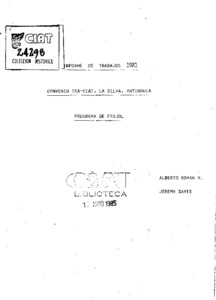Informe de trabajos 1981: programa de frijol
A summary is presented of results of trials conducted as part of the collaborative agreement between the Instituto Colombiano Agropecuario and CIAT on bean research during 1981 in La Selva, Antioquia (Colombia). During germplasm evaluation, 112 promising materials were identified for their adaptation and healthiness; 67 of these are of interest for Colombia and the andean zone. Two medium red materials were selected as outstanding in the preliminary screening trial of the germplasm bank. In addition, 33 materials were identified as having desirable characteristics to be used as parents in the breeding program. In crosses carried out in 1981, incorporation of resistance to the most limiting diseases (anthracnose, angular leaf spot, and Ascochyta) was considered for the following materials: ICA-Viboral, Calabozo, Radical, Liborino Voluble, and Linea 32980 M-8. From the F2 to F6 selection nurseries, 1167 materials of interest for Colombia and the Andean zone were selected; these had Colombian materials combined with disease-resistant sources as parents. The following materials were more frequently used in the crosses: Cargamanto, Linea 32980 M-8, Antioquia 48, Liborino Voluble, Linea 32980 M-4, and ICA-Viboral. Advanced lines were included in regional trials planned for 1982 in the municipalities of El Carmen de Viboral, Marinilla, and San Vicente (Antioquia). In a maize x bean intercropping trial, it was found that beans yield more in double rows, 0.23 m apart, with maize intercropped at 0.92 x 0.30 m. In the maize x bean relay trial, it was found that the best treatment was 2 maize plants x 3 bean plants/hill, spaced 0.46 m apart, and rows separated by a distance of 0.92 m. In a preliminary herbicide trial, metolachlor provided the best control during preemergence. In the maize x bean relay trial, the mixture metolachlor + glyphosphate was promising during bean preemergence. (AS (extract)-CIAT)

